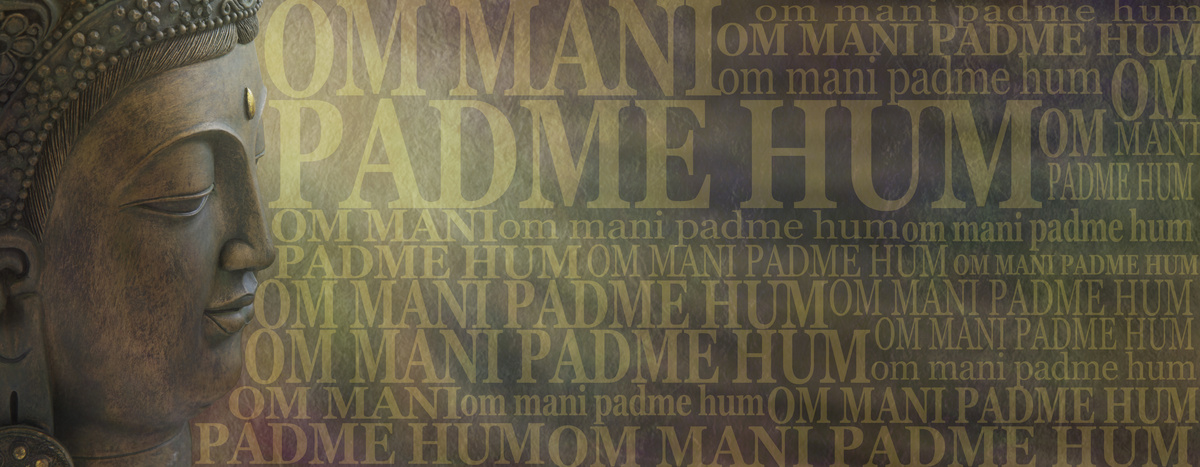Table of contents
What are mantras?
The word mantra is composed of two meanings: "man" being a definition of mind, and "tra" referring to instrument or vehicle. Mantras are words, phonemes, syllables or phrases used as a way to guide the mind, providing greater concentration and vibrational balance to the human psyche and body.
Mantras are usually written in Sanskrit; an ancient language in India and Nepal. Their oldest records are found in the Vedas; sacred texts of the Indian culture discovered more than 3,000 years ago that treat mantras as a connection with divine and universe energies.
Mantras are not limited to the repetition of words or phrases. They should be chosen according to the purpose and intention on the part of the one who chants them and the vibrational power they provide.
In this article you will follow a study of mantras and the power of words in different philosophies and religions. We will also go through the various uses to which they are applied as well as specific meanings of the main mantras existing in different cultures as well as their physical, mental and spiritual benefits.
The power of words and mantras

In the most diverse lines of human thought, whether religious or philosophical, one thing is certain: the word has power. It is through it in its spoken and written form that human beings express themselves and show their emotions and intentions, and it is through the word that humanity writes its history.
We will see below how the understanding of the power of words, according to the main philosophies and religions, applies to all aspects of our life, being of vital importance for the expansion of our consciousness and for the way we walk our paths during our existence.
The power of words according to the Bible
The power of words, according to the Bible, has a central and divine role. There are numerous biblical references to the power of words, beginning with the origin of creation.
The opening sentence of John's Gospel in the book of Genesis says, "In the beginning was the word, and the word was with God, and the word was God," making it clear that the creation of time, the universe, and everything in it originated in the word, and that God is the word itself.
The word is the main north followed by Christians, being food for the spirit and guidance for all the ethical and moral principles of a person's life.
We have a clear example in Matthew 15:18-19, "But the things which proceed out of the mouth come from the heart, and these are the things which make a man unclean; for out of the heart proceed evil thoughts, murders, adulteries, sexual immorality, thefts, false witness, slander."
The power of words according to Kabbalah
According to Kabbalah, a Jewish philosophical-religious system of medieval origin, the power of words is directly linked to the negative or positive energetic impact it causes, whether spoken, heard or even thought by an individual.
In Kabbalah, letters and words are considered raw materials of creation and each is a channel for specific divine energies.
The words we use every day, thought or spoken, perform a central function in the development of our perspective and feelings. Our feelings generate actions and these generate effects. Everything begins with words.
Following this logic of the Kabbalah, we are able to create or destroy through words. The words used give life to things and changing the use of negative words for positive ones will inevitably create something new and favorable.
The power of words according to western philosophy
The power of words for Western philosophy is found in making our thoughts known to others. The transmitter of the word translates private thoughts into words, and the receiver translates back into thoughts.
According to Western philosophy, we should first have a concrete idea about what we are going to talk about, and our words should be based on experience.
This more realistic approach to words resulted in religious persecution over the centuries, as these ideas were dissonant with the divine conception of many words as much as the Christian Jewish tradition.
Western philosophy treats words as practical tools in improving the world for ourselves and those around us.
The power of words according to oriental philosophy
The oriental philosophy has in the word a very spiritual focus. The mantras, which have their origin in the Indian culture, are considered as pure and divine expression that harmonizes the human being with the universe and the divinities.
In Japanese culture we have the term kotodama, which means "spirit of the word". The concept of kotodama presumes that sounds affect objects and that the ritual use of words influences our environment and our body, mind and soul.
This conception of the power of the word with a strong spiritual and divine focus is also present in Tibetan, Chinese, Nepalese and other eastern countries that share Buddhist spirituality.
The sound as a manifestation of mantras

Sound has unlimited properties in human transformation and healing. It affects us on the physical, mental, emotional and spiritual levels, being the manifestation of intentions and desires, and scientifically proven as to its property of reorganizing the molecular structure of matter.
Like everything in the universe, our physical body is in a vibrational state. Our state of physical and mental health depends directly on the harmony of vibration of the different parts of the body.
Sound as a vibrational manifestation is key in physical healing processes, being used by modern science, spiritual and energetic by ancient cultures through mantras.
The most significant manifestation of sound is our own voice. Whether in written, spoken or thought form, the intention that originates the emitted sound is directly related to the vibrational form and its effects. Let us analyze the origin of the word mantra and how they work, what they are for and the importance of understanding their meanings.
Origin of the word "mantra
The earliest and oldest records about mantras originate in the Vedas, the ancient Indian scriptures of over 3,000 years old. "Mantra" comes from the Sanskrit "Mananāt trāyatē iti mantrah", which means the sustained repetition (Mananāt) of that which protects (trāyatē) from all miseries arising from human tribulations or the cycles of birth and death.
The origin of mantras comes from the primordial sound OM, which is considered the sound of creation. Scholars, seers and sages who have resorted to mantras in search of wisdom have discovered the science of this technique. When put into practice, it removes obstacles to human growth by providing the realization of the goals of each spiritual being in human form.
How mantras work
As a physical tool, the mantra works as a brain harmonizer. Through vocalization of phonemes the mantra triggers certain areas of our brain through sound resonance.
It is through our five senses that the brain connects with the outside world, and the mantra puts us at a point beyond these senses, where the mind is in a total state of peace and concentration.
In a spiritual way the mantra connects us with divine forces beyond human comprehension and chanting them elevates us to a state beyond the conception of space and time.
What mantras are for
The primary function of mantras is to aid in meditation. The human brain is a mechanism that does not stop, and letting go of thoughts about everyday life is not an easy task.
Mantras serve as an anchor for the human psyche to enter a state of tranquility, thus allowing one to enter a state of relaxation and concentration.
For millennial traditions, mantras are seen as prayers that raise the consciousness, connecting the being to divine energies.
What are the benefits of chanting mantras
The benefits of chanting mantras reflect on the human body as a whole. In addition to being an ancient technique to aid meditation and concentration, mantras also ease or eliminate anxieties. They increase the information processing capacity in the brain, providing tranquility and emotional stability.
For the physical body, mantras aid respiratory and cardiovascular function. Scientific studies have also shown that chanting mantras increases the production of substances related to well-being and immunity, such as endorphin and serotonin.
Do I need to know the meaning of the mantra?
What transcends the mantra beyond a mere physical instrument is the intention that is placed when chanting it and the meaning of each phoneme or vocalized phrase.
A mantra chanted with sincere intention and with knowledge of its meaning releases all the energetic and spiritual potentiality that the phrase or phoneme carries. This enables the connection with divine energies, raising the consciousness to a state beyond the conception of space and time.
Meanings of some well-known mantras

The first step for those who think about starting the practice of mantras is to understand their meaning. Through the understanding of what each phrase or syllable means, it is possible to reach the full potential of each mantra, besides being essential in the choice according to the objective sought by who intones it.
Below, we will talk in more detail about very popular mantras, such as the Om, the Hare Krishna, the Hawaiian Ho'ponopono, and we will also talk about lesser known mantras, such as the maha mantra of Shiva, the mantra of Ganesha, and several others.
The mantra Om
The mantra Om, or Aum, is the most important mantra. It is considered the frequency and sound of the universe, and is the point of confluence between various cultures, such as Hinduism and Buddhism, which have this mantra as the root for all others.
It is formed by the diphthong of the vowels A and U, and the nasalization of the letter M at the end, and for that reason it is often written with these 3 letters. For Hinduism, Om corresponds to the three states of consciousness: wakefulness, sleep and dream.
The mantra Om, or primordial sound, frees the human consciousness from the limits of ego, intellect and mind, uniting the being to the universe and God Himself. When chanting this mantra consistently, one clearly notices the vibration originating in the center of the head expanding to encompass the thorax and the rest of the body.
Krishna's maha mantra, Hare Krishna
"Hare Krishna, Hare Krishna,
Krishna Krishna, Hare Hare
Hare Rama, Hare Rama
Rama Rama, Hare Rama"
Krishna's mantra is recognized by ancient Vedic literature as the most important mantra of that era. It means "Give me divine will, give me divine will, divine will, divine will, give me, give me. Give me joy, give me joy, joy, joy, give me, give me."
In the words of this mantra lies the power of the energetic manifestation of the throat chakra, which for Hindus refers to the energy of the first ray of God's will.
The Maha mantra, or "the great mantra" in Sanskrit, is widely used in Hindu spiritual practices and its origin, although unclear, dates back to the primordial texts contained in the Vedas, ancient Indian scriptures of more than 3000 years.
Shiva's maha mantra, Om Namah Shivaya
"Om Namah Shivãya
Shivãya Namaha
Shivãya Namaha Om"
The Maha mantra of Shiva, or Om Namah Shivaya, means: "Om, I bow before my divine inner Self" or "Om, I bow before Shiva". It is often used by Yoga practitioners in meditation, and provides deep mental and physical relaxation, having healing and relaxing effects.
"Namah Shivaya" has in its words the five actions of the Lord: Creation, preservation, destruction, the act of concealing and the blessing. They also characterize the five elements and the whole creation through the combination of the syllables.
The maha mantra of Ganesha, Om Gam Gana Pataye Namaha
"Om Gam Ganapataye Namaha
Om Gam Ganapataye Namaha
Om Gam Ganapataye Namaha"
Ganesha's Maha mantra translated from Sanskrit means, "Om and salutations to him who removes obstacles of which Gam is the seminal sound." or "I salute you, Lord of the troops."
This mantra is considered a strong request for protection in times of imminent danger. Ganesha is the first son of the gods Shiva and Pavarti, thus being one of the most important deities for Hindus.
This deity is represented with a human body and an elephant's head, and is also related to duties and the communication of universal intelligence and wisdom.
The mantra Om Mani Padme Hum
"Om Mani Padme Hum"
Also known as Mani mantra, the Om Mani Padme Hum translated from Sanskrit means: "Oh, jewel of the lotus", or "from the mud the lotus flower is born". It can be said that this mantra is one of the best known in Tibetan Buddhism.
Used to drive away negativity and connect us with our capacity for unconditional love, it was created by Buddha Kuan Yin, who represents the compassion of all the other Buddhas, as well as being called the Goddess of Compassion by Chinese mythology.
The Hawaiian mantra of self-healing, Hoponopono
"Ho' ponopono"
Translated from Hawaiian, it means "to right a wrong" or simply "to correct". It can be chanted by anyone, regardless of the time of day or place they are in.
Hoponopono is an ancient Hawaiian mantra used as a spiritual cleansing of bad energies and feelings. It evokes forgiveness, inner peace and gratitude, and is widely used by Hawaiians in everyday life.
This mantra is the reproduction of four phrases: "I am sorry", "Forgive me", "I love you" and "I am grateful", and guides the person who intones it through the four sentimental stages: repentance, forgiveness, love and gratitude.
Gayatri mantra
"Om bhur bhuva svar
Tat savitur varenyam
Bhargo devasya dhimahi
Dhiyo yo nah prachodayat"
Also known as the prosperity mantra, the Sanskrit translation of the Gayatri mantra is, "O God of life that brings happiness, Give us Your light that destroys sins, may Your divinity penetrate us and may inspire our mind."
This mantra is a simple prayer with the purpose of bringing enlightenment to the mind and attitudes. Considered the most powerful and complete of mantras, Gayatri is considered by Hindus as the mantra of enlightenment.
The ancestral mantra of the Saccha lineage, Prabhu Aap Jago
"Prabhu aap Jago
Paramatma Jago
Mere Sarve jago
Sarvatra jago
Sukanta ka khel prakash karo"
Considered a powerful mantra of spiritual awakening, the Prabhu Aap Jago translated from Sanskrit means "God awaken, God awaken in me, God awaken everywhere, End the game of suffering, Light up the game of joy".
For Hindus, chanting this mantra with sincere intention and knowing its meaning makes it a prayer from God to God, and it can be chanted anytime you lack harmony, love, peace and joy in your life.
Other particularities of mantras

Besides being millennial forms of prayer in various cultures, mantras also have other applications.
Since a form of meditation, being used also in Yoga practice and for alignment and activation of the 7 chakras, mantras have several applications and curiosities. Check in the rest of the article.
Mantras and meditation
For many meditation practitioners, silence is essential, but the human mind has a natural tendency to lose focus and concentration. Mantras, in this case, are effective tools to guide the practitioner, enabling total relaxation and freeing the mind from unwanted feelings and emotions.
As much as they are often used as forms of prayer, mantras are not supernatural words. They are a kind of fulcrum in which the brain can release all its dormant potential.
The posture and speed in which you chant, the number of repetitions, body posture and breathing during the practice of meditation are very important and should be observed, as well as the meaning of the chosen mantra.
Mantras and yoga
Mantras are used by Yoga practitioners as a way to enhance the benefits of this technique. One of the pillars of yoga is the chanting of mantras, which are key in the execution of various exercises, because they bring concentration and prevent practitioners from losing mental focus.
Although it is not religious, Yoga has as its origin India and the millenary physical disciplines. With breathing techniques, body movements and specific body postures, the practice of yoga is directed according to the specific goal of each practitioner.
Mantras and the 7 chakras
Translated from Sanskrit, chakra means circle or wheel, and are the magnetic centers spread throughout the human body. They are found all along the spine, and their influence is linked to the vital organs in different areas of the body. There are several chakras, but there are 7 main ones.
There are specific mantras to activate each of the seven chakras, called Bejin or seminal mantras. Check out each of the seven chakras and their respective mantra:
1º- Base Chakra (Muladhara): Mantra LAM
2º- Umbilical Chakra (Svadisthiana): Mantra VAM
3º- Solar plexus and umbilical chakra (Manipura): Mantra RAM
4º- Heart Chakra (Anahata): Mantra YAM
5º- Throat Chakra (Vishuddha): Mantra RAM
6º- Frontal Chakra or 3rd eye (Ajna): Mantra OM or KSHAM
7º- Heart Chakra (Sahasrara): Mantra OM or ANG
The energetic balance of the 7 chakras is related to the proper functioning of various biological and mental functions, as well as diseases may arise if they are misaligned or deactivated.
Curiosities about mantras
Among the numerous peculiarities related to mantras, there are some interesting curiosities, such as the following:
- The mantras were references and inspirations for famous artists in the world of modern Western music. The Beatles, for example, used the mantra "jai guru deva om" in the lyrics of "Across The Universe" (1969).
- Madonna, a student of Kabbalah, had strong influences of mantras in her work, and even composed a song in Sanskrit called Shanti/Ashtangi from the album "Ray of light" (1998).
- In order not to get lost due to repetitions of the phrases or syllables of mantras, some practitioners make use of a kind of rosary called japamala.
- A mantra must necessarily be created in some dead language, so that no modifications can occur because of dialect differences.
- When creating a mantra, all the phonemes and sound are thought of on an energetic basis, and this energy of the mantra is compared to fire.
Can chanting mantras promote well-being?

Whatever the form or objective sought by those who study and chant mantras, one thing is certain: they are effective tools in promoting physical, mental and spiritual well-being.
As much as they have a mystical and spiritualist foundation, the mantras are related to the resonances and vibrations of energies, being targets of scientific studies that prove their reflexes in matter and, consequently, in the human organism.
If you seek in mantras physical, mental or spiritual improvement, seek to deepen your knowledge of this ancient technique. Keep in mind that the more sincere your intention when chanting the mantra and the more you know its meaning, the greater will be its benefit, whatever your goal.

